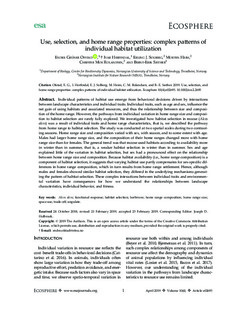| dc.contributor.author | Ofstad, Endre Grüner | |
| dc.contributor.author | Herfindal, Ivar | |
| dc.contributor.author | Solberg, Erling Johan | |
| dc.contributor.author | Heim, Morten | |
| dc.contributor.author | Rolandsen, Christer Moe | |
| dc.contributor.author | Sæther, Bernt-Erik | |
| dc.date.accessioned | 2019-09-25T16:24:59Z | |
| dc.date.available | 2019-09-25T16:24:59Z | |
| dc.date.created | 2019-03-25T11:16:31Z | |
| dc.date.issued | 2019 | |
| dc.identifier.citation | Ecosphere. 2019, 10:e02695 (4), 1-14. | nb_NO |
| dc.identifier.issn | 2150-8925 | |
| dc.identifier.uri | http://hdl.handle.net/11250/2618828 | |
| dc.description.abstract | Individual patterns of habitat use emerge from behavioral decisions driven by interactions between landscape characteristics and individual traits. Individual traits, such as age and sex, influence the net gain of using habitats and associated resources, and thus the relationship between size and composition of the home range. However, the pathways from individual variation in home range size and composition to habitat selection are rarely fully explored. We investigated how habitat selection in moose (Alces alces) was a result of individual traits and home range characteristics, that is, we described the pathway from home range to habitat selection. The study was conducted at two spatial scales during two contrasting seasons. Home range size and composition varied with sex, with season, and to some extent with age. Males had larger home range size, and the composition of their home ranges changed more with home range size than for females. The general trend was that moose used habitats according to availability more in winter than in summer, that is, a weaker habitat selection in winter than in summer. Sex and age explained little of the variation in habitat selection, but sex had a pronounced effect on the relationship between home range size and composition. Because habitat availability (i.e., home range composition) is a component of habitat selection, it suggests that varying habitat use partly compensates for sex‐specific differences in home range composition, which in turn results from home range settlement. Hence, although males and females showed similar habitat selection, they differed in the underlying mechanisms generating the pattern of habitat selection. These complex interactions between individual traits and environmental variation have consequences for how we understand the relationships between landscape characteristics, individual behavior, and fitness. | nb_NO |
| dc.language.iso | eng | nb_NO |
| dc.publisher | Ecological Society of America | nb_NO |
| dc.rights | Navngivelse 4.0 Internasjonal | * |
| dc.rights.uri | http://creativecommons.org/licenses/by/4.0/deed.no | * |
| dc.title | Use, selection, and home range properties: complex patterns of individual habitat utilization | nb_NO |
| dc.type | Journal article | nb_NO |
| dc.type | Peer reviewed | nb_NO |
| dc.description.version | publishedVersion | nb_NO |
| dc.source.pagenumber | 1-14 | nb_NO |
| dc.source.volume | 10:e02695 | nb_NO |
| dc.source.journal | Ecosphere | nb_NO |
| dc.source.issue | 4 | nb_NO |
| dc.identifier.doi | 10.1002/ecs2.2695 | |
| dc.identifier.cristin | 1687463 | |
| dc.relation.project | Norges forskningsråd: 244647 | nb_NO |
| dc.relation.project | Norges forskningsråd: 223257 | nb_NO |
| dc.description.localcode | © 2019 The Authors. This is an open access article under the terms of the Creative Commons Attribution License | nb_NO |
| cristin.unitcode | 194,66,10,0 | |
| cristin.unitname | Institutt for biologi | |
| cristin.ispublished | true | |
| cristin.fulltext | original | |
| cristin.qualitycode | 1 | |

